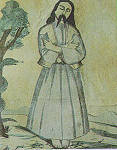| Part of a series on Nizari-Ismāʿīli Batiniyya, Hurufiyya, Kaysanites and Twelver Shī‘ism |
|---|
|
|
Kaygusuz Abdal (1341–1444) was a Turkish folk poet of the 14th century.
Background
[edit]
In the 14th century Alaiye was the capital of the small Alaiye beylik (principality). Kaygusuz Abdal was born in or near to Alaiye (modern Alanya, Antalya Province of Turkey). His name was Alaattin Gaybi and Kaygusuz Abdal was his pseudonym. According to tradition he was a bey's son (i.e., prince). But instead of politics he chose to be a dervish. His tutor was Abdal Musa.[citation needed]
Life
[edit]Details of his life and travels are ambiguous. Most of the stories attributed to him are not reliable. His works however convey that he travelled to many places. He travelled to Mecca for Hajj. He also visited Damascus, Najaf and Karbala. There are unreliable accounts of his visits to cities in the Balkans like Yambol, Plovdiv (now both in Bulgaria), Bitola (now in the Republic of Macedonia) and Edirne (now in Turkey). In Egypt he gained the title Abdullah Magaravi ("God's servant living in a cave") after spending several years in seclusion.[1]
Works
[edit]His poetic works include:[2]
- Divan,
- Gülistan,
- Mesnevi-i Baba Kaygusuz (3 Vol.),
- Gevher-nâme,
- Minber-nâme.
His other works are:[2]
- Budala-nâme,
- Kitab-ı Miglate,
- Vücûd nâme.
- Saray-nâme
- Dilgüşâ.
References
[edit]- ^ "Aşık veysel Folk poets page" (in Turkish). Archived from the original on 2013-09-27. Retrieved 2012-04-05.
- ^ a b İstanbul University Faculty of Literature (in Turkish)
Well, that’s interesting to know that Psilotum nudum are known as whisk ferns. Psilotum nudum is the commoner species of the two. While the P. flaccidum is a rare species and is found in the tropical islands. Both the species are usually epiphytic in habit and grow upon tree ferns. These species may also be terrestrial and grow in humus or in the crevices of the rocks.
View the detailed Guide of Psilotum nudum: Detailed Study Of Psilotum Nudum (Whisk Fern), Classification, Anatomy, Reproduction